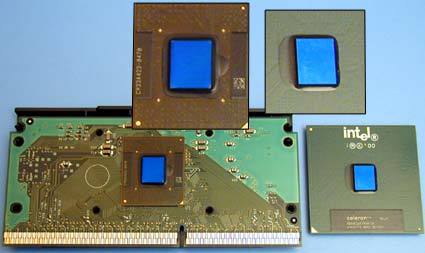The Resurrection: Pentium III 1.4 GHz on Slot-1 Motherboards
The Genesis Of The P-III
The Pentium III finds its roots in the Pentium II, which, in turn, is based on a modernized Pentium Pro core. All three have one thing in common - the L2 cache is either integrated into or very near the processor core. Due to its on-die cache, the Pentium Pro was a gigantic chip by today's standards, making it very expensive to produce. To reduce costs, Intel decided to move the cache out of the die and put both on a little PCB instead (Pentium II Klamath). This PCB was no longer inserted into a classic pin-socket, but into a long slot (Slot-1). Concurrently, Intel also introduced SDRAM (66 MHz).
With the introduction of the next-generation core (Deschutes), Intel raised the system clock speed from 66 MHz to 100 MHz. Of course, this also meant a new chipset was required, and this is where the 440BX comes in. It would dominate the market for over a year, as it offered great performance thanks to its 100 MHz SDRAM, was rock-stable, and also easy to overclock. In short, it was quite the dream chipset. The switch from Pentium II to Pentium III happened with the introduction of the Katmai core, which was also the first core to include Intel's new SSE SIMD extensions.
Pictured: Pentium III Coppermine as a Slot-1 version (Pentium III E or EB), front and back side.
It wasn't until the next generation, called Coppermine, that the L2 cache would be re-integrated into the die (Pentium III E, pictured above). The i820 (Camino) chipset was planned to be the successor to the very popular BX. Intel hit a snag here, though - the RDRAM version drove system costs up to levels most buyers were unwilling to accept, and the SDRAM version was troubled by instabilities and performance penalties due to the memory translator hub (MTH). As a result, the BX chipset remained the only viable P-III platform aside from VIA's Apollo Pro 133A. As its name implies, the Apollo 133A's FSB speed was raised to 133 MHz (Pentium III EB), with the memory speed following suit (PC133 SDRAM).
With the Coppermine core, the Pentium III was able to break the 1 GHz barrier a short while after the Athlon first accomplished this feat (yes, AMD was faster), only to hit another snag at 1.13 GHz. (Tom's Hardware played a major role in discovering this fault.) Meanwhile, the BX was being replaced by the i815 (Solano) chipset, which was officially validated for 133 MHz operation. It was also this chipset that finally marked the end of the Slot-1 era and introduced the UltraATA/ 100 interface to the mass market.
Even though the Pentium 4 was supposed to supersede the Pentium III, the latter still represented the more mature platform, convincing Intel to give the core one last major overhaul (Tualatin). It's main target: servers and notebooks. Unlike all previous versions (Deschutes, Katmai, Coppermine), Tualatin no longer used the same pin-out, making it incompatible with previous socket 370 boards. Again, this was a deliberate move on Intel's part, with the aim of hastening the P4's acceptance, a development deemed necessary to overcome the pressure Intel faced from AMD's Athlon XP.
P-III Or Celery?
Another processor line that has matured over time is the Celeron family. This is hardly surprising, since it, too, is based on the Pentium III core. To set the Celeron apart from its bigger brother, Intel has always limited the Celeron's L2 cache or its FSB (or both), quickly and effortlessly turning it into a low-cost chip. It, too, went through all of the P-III architecture's generational growth spurts and is available at speeds up to 1.4 GHz today.
Get Tom's Hardware's best news and in-depth reviews, straight to your inbox.
Tualatin Processors Compared
| Header Cell - Column 0 | Pentium III | Celeron |
|---|---|---|
| Socket | Socket 370 | Socket 370 |
| Clock Speeds | 1.13, 1.2, 1.26, 1.33, 1.4 GHz | 1.0, 1.1, 1.2, 1.3, 1.4 GHz |
| FSB-Speed | 133 MHz | 100 MHz |
| L2-Cache | 512 kB | 256 kB |
| L2-Speed | Processor speed | Processor speed |
Slot-1 Coppermine and its Socket 370 counterpart (here: Celeron). The processor's die is technologically and visually identical. Slot-1 versions are no longer available today.
Which of the above is the better choice for you depends on two factors - the platform available (your motherboard) and how much you are willing to spend on an upgrade. The 1.4 GHz Pentium III is anything but cheap, still carrying a price tag of roughly $250. The Celeron, on the other hand, is a much cheaper proposition - the 1.4 GHz version can be found priced as cheap as $80! Although its performance is lower, the Celeron has the advantage of working on almost any motherboard (together with a PowerLeap adapter), due to the fact that it uses a 100 MHz FSB and not 133 MHz.
Current page: The Genesis Of The P-III
Prev Page Not Dead Yet: Breathing New Life Into The BX Chipset Next Page Motherboard And Processor: Requirements For Smooth Operation
Patrick Schmid was the editor-in-chief for Tom's Hardware from 2005 to 2006. He wrote numerous articles on a wide range of hardware topics, including storage, CPUs, and system builds.

